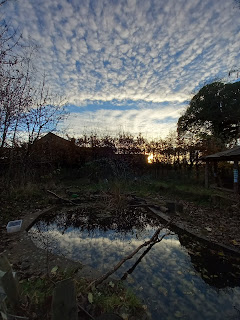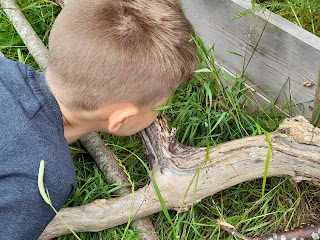Indoor Forest School
I've said before that I have a large IKEA blue bag that I keep certain activities in, these are not necessarily ones I can/will use in Forest School, like jigsaw puzzles, colouring, cutting out, etc. It's fairly quick to add some of the nature table items, bug ID, and bird guides, etc. into the bag to make what is basically 'nature learning' feel a little like Indoor Forest School!
One week in December started with me under the duvet with a fever and headache, and a PCR test pending. School canceled Forest School because waiting each day to decide what the following day's timetable would be was too hectic. So once back in on the Wednesday indoor Forest School was planned as none of the children were dressed for the icy mud bath that is our dig pit in Winter!
With 2022 and a new Term starting there is the potential for more reasons to halt sessions. Firstly, weather - high winds are more likely, and the Gulf Stream likes to throw a few thunderstorms our way too. Secondly, illness - not only is winter norovirus and cold/flu season, but Covid is now rampant and following Christmas get-togethers there is an ongoing staffing issue ready to scupper the average school week! There is nothing worse than suddenly finding you cannot use your outdoor space when tree climbing, mud kitchen potions, and bird spotting are on your planning! So I thought I would share some of what I take to a classroom.
These sessions in the pictures were from sessions with EYFS and Year 1, but I'll try to explain what I've done with older groups also.
Some things are fairly obvious, like colouring in, but if I can I prefer to set up leaf rubbing, or close observation of some natural objects to try to draw. I laminate a few Autumn leaves each year and you can do colour mixing to match, or challenge the children to draw the venation. I've had children make mini zig-zag reference books of a few leaves they like the look of, and (age-dependent) write descriptions of the margins, veins, and type of leaf it is. In this photo year 1 is cutting out the leaves they made and adding it to a cardboard box for a (toy) hibernating hedgehog to snuggle into! In the past I have also made salt dough rounds that the children can press the leaves, twig, seeds and flowers into to make an impression that can then be painted when dry.
Books are always a good idea! Some great stories about nature, weather, and seasons. Picture books work well for most age groups as the older children can read them independently. There are many picture books that are aimed at older children, and even some lift the flap books take on a whole new meaning when the children are reading it for themselves. Non-Fiction books are great for the 'wow' factor, close-up photography and endless facts for those who love that sort of detail. I always put some small world insects with the reference books to attract those children who need to hold something while doing what is a mostly quiet activity.
Apologies for the blurry pictures (taken quickly on my phone!) but I also have life cycle pieces for bees, ants, stag beetles, ladybirds and butterflies. These I usually put out with laminated info sheets on those insects, young children can match the eggs/larvae/insects etc, and older children can keep the sheets face down and challenge themselves to get it right!
Having letter tiles, or magnetic letters, or letters on wood cookies with toy birds opens up phonics and spelling as an extra challenge. I have had children make 'crosswords' (IE making ROBIN downwards using the I in Blackbird), and even a basic cross between scrabble and card games, where each child has ten tiles each and can ask to swap until someone has a bird name to lay down! These birds are the kind that sing when you squeeze them, so learning the sounds, puppet shows, and nest building can also be activities around them.
This jigsaw is multilayer, so although small it is still challenging! There are three layers, each layer shows a scene for planting and growing. Older children can be challenged to complete it within a certain time!
The Woodland Trust does downloadable 'Top Trumps' cards for trees, I also have some for bugs. When children are too young to use these I can put just a couple or so out with that trees leaves and seeds for the children to explore and match.
Taking twigs and leaves, berries and seeds into a classroom allows for much creative artwork. They can also be used to count, sort, or make something the adults have never thought of! Loose Parts play at its best!
These are the only activities I have photos of! But there are easily downloadable word searches, colouring sheets, and crosswords that can be added in. I have paint swatches that can be used to match against Autumn Leaves. I have brought peelers and twigs inside, and yarn and sticks to wrap as wands. I have a Noughts & Crosses board etched onto a large trunk slice that can come inside with me. I have an assortment of shoelaces and info cards on knot tying. I have pestles and Mortars that can grind berries and charcoal to make ink... and all sorts of weaving that can be done in a classroom.
Whatever activities I have are set up either in an EYFS Freeplay style, where the children can wander as they wish to whichever activity they want to try next or as a carousel that children can move around in groups. This will always depend on space and the number of children that you have inside.
Luckily I very rarely have to take a session indoors, so even if I bring out the same activities, or more likely a variation on the same activities, it will have been a while since that class had the opportunity to explore them, and if they are older, they will access them a different way.
The session is usually structured with a carpet session first, a chance to discuss why we can't be outside, and to introduce what is available to do. It can then end with a plenary, can they relate what they chose to do today with something they have done outside in Forest School before, has it given them an idea of what they'd like to do when they finally get to go back outside?
The children can help to pack things away and a story is always a great way to end any session.
If a session is suddenly moved to an inside venue then planned themes etc become null and void! My bag of indoor activities is an add-on, I have a permanent plan written out in case I need to use it, this names the activities and makes it clear it will be differentiated to suit purpose. Sticking to basecamp routine, even sitting the class in a circle on the carpet to mimic it, reinforces that this session is about nature and wildlife, plus talking before and after helps to reinforce the links to what the children do outside.
I have no idea how helpful any of this is! I have had many people contact me asking what I do when I have to cancel a session and I thought this may be the easiest way to reply!
If you have any great indoor Forest School Activities to share - please add them in the comments below!
















Comments
Post a Comment